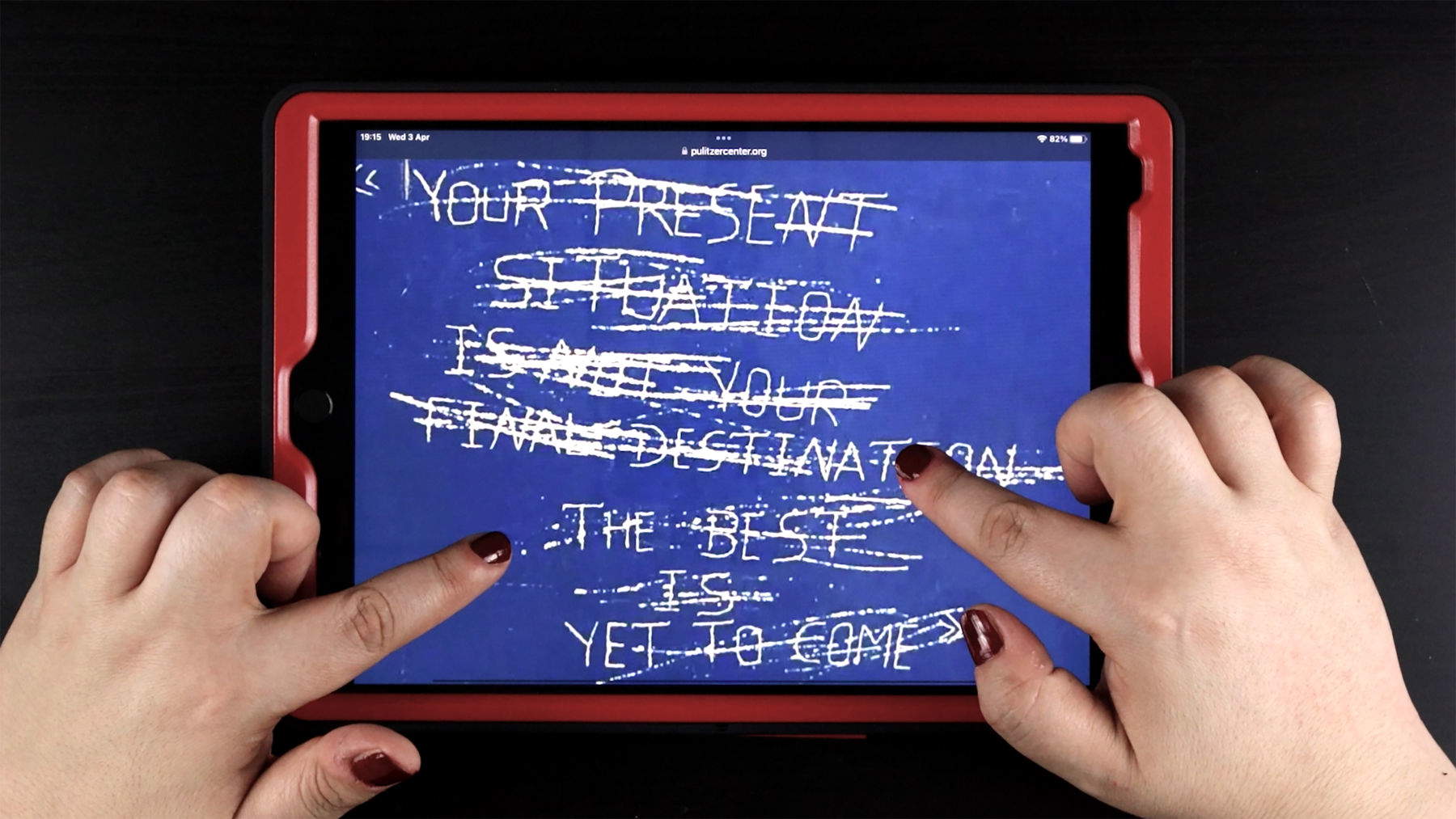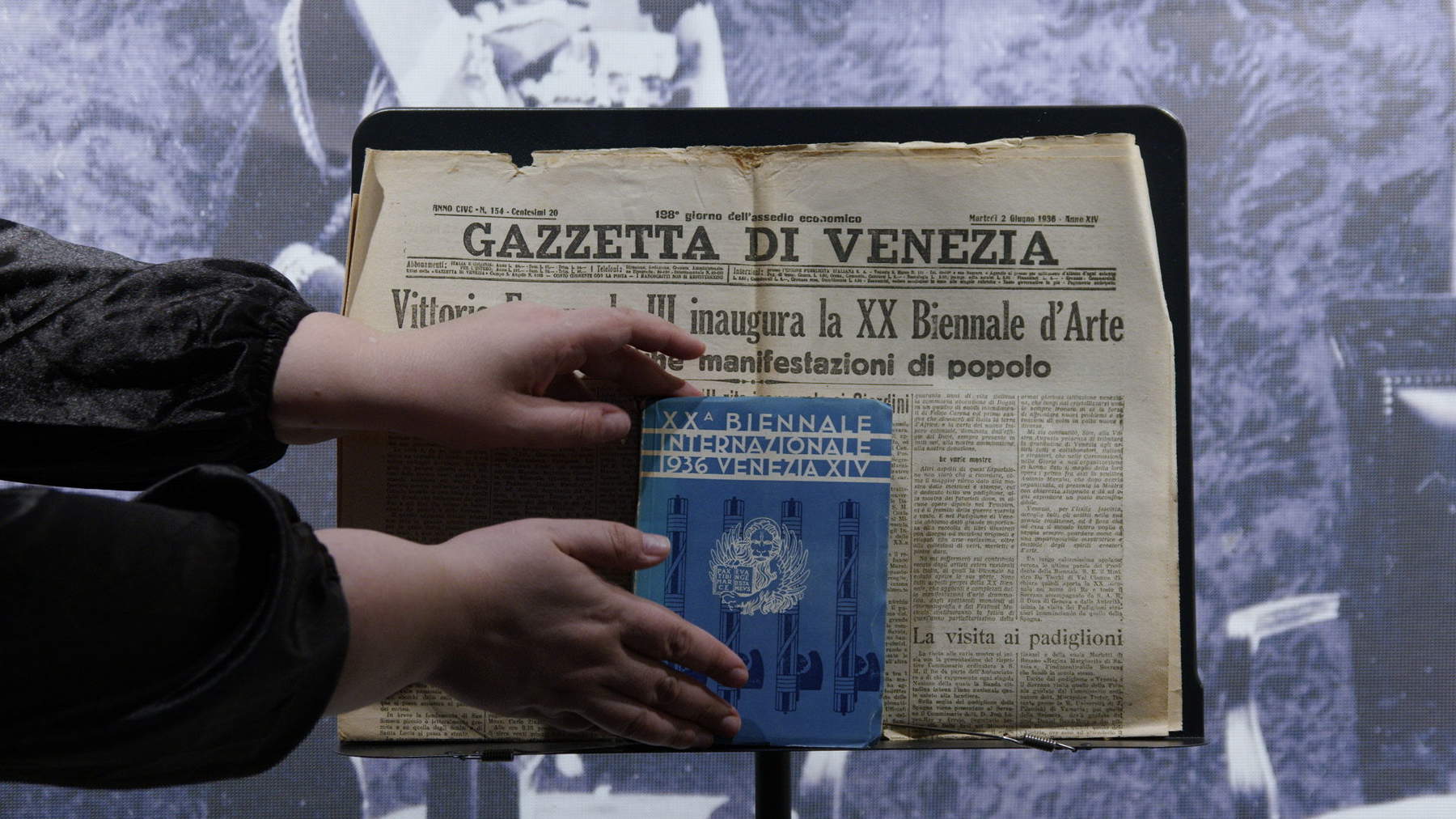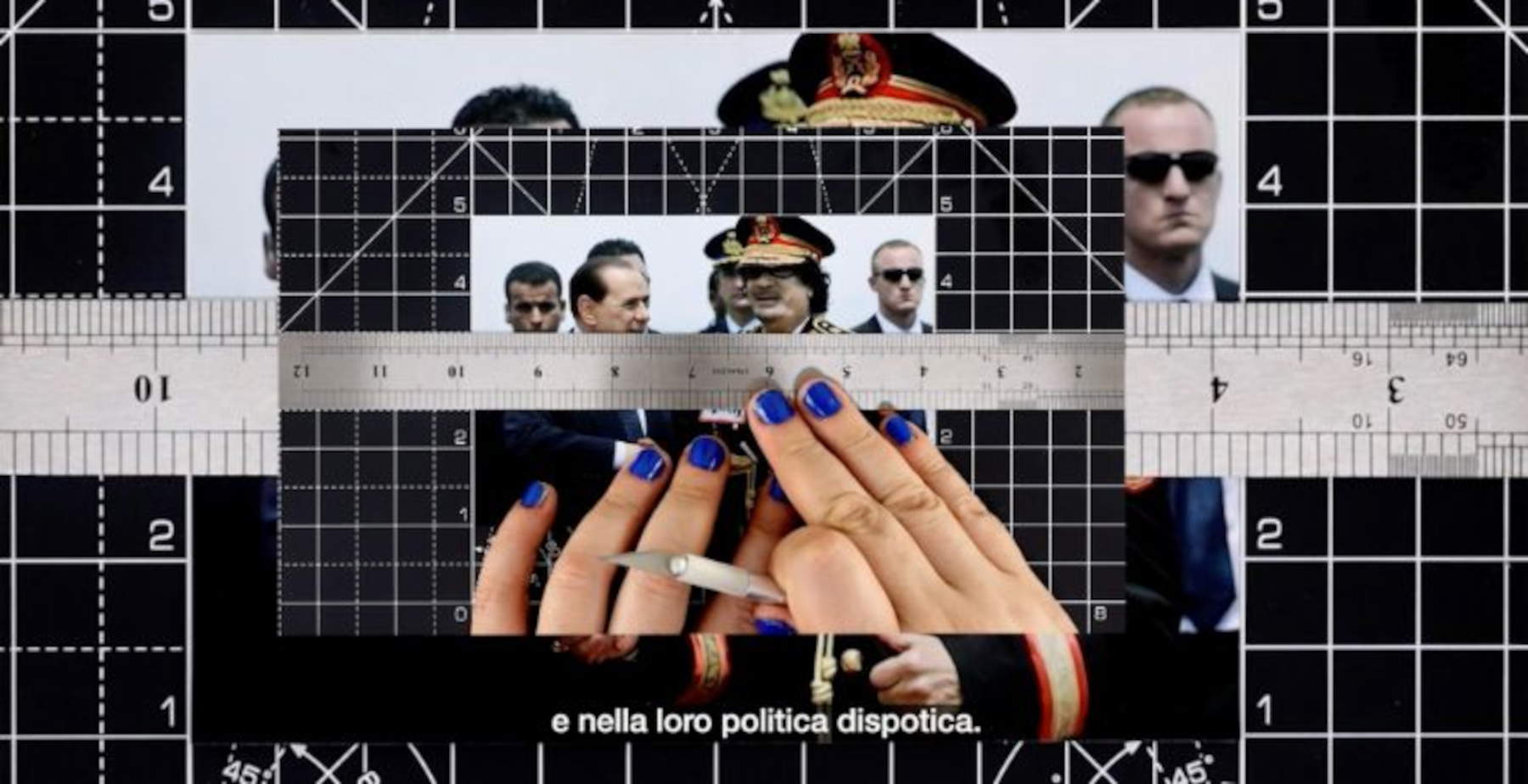At the Fondazione Sandretto Re Rebaudengo in Turin opens, from June 12 to October 12, 2025, I Saw a Dark Cloud Rise, a solo exhibition by Alessandra Ferrini. The exhibition offers a complex reflection on the link between imagination, technology and ideology, articulating around a three-channel video installation that gives the title to the entire project. The work stems from the artist’s long research on the legacy of Italian colonial violence in Libya, with particular reference to the Italian-Turkish War of 1911-1912. The work takes the form of a layered study that weaves together documents, iconographies and visual power structures to open up questions about how colonialist thought influenced the development of vision technologies, contributing to the construction of an imperial collective imaginary.
The exhibition is developed in two distinct environments. The first space, conceived as a reading room and called a “decompression space” by the artist, presents diagrams, texts and materials that allow contextualizing the issues addressed in the video. It is an environment in which the viewer is invited to become familiar with the sources and references that make up the theoretical framework of the work. The second space houses the video installation proper, a work that analyzes in depth the relationship between propaganda, military technologies and historical iconography, tracing the connections between the emergence of modern air warfare practices and the formation of an imperialist vision based on abstraction, distance and superiority of the gaze.


Ferrini’s research focuses on a period of Italian history rarely investigated with similar attention: the years immediately preceding World War I. The Italian-Turkish War, a conflict that led to the colonial occupation of Libya in 1911, represents for the artist a crucial node for understanding the intersection between nationalist ideology, wartime modernization and aesthetic experimentation. It was precisely in Libya that, for the first time in military history, the airplane was employed in bombing operations, flanked by the development of new wireless technologies. This event marked a change in the representation of the conflict, generating a new kind of top-down view that the artist questions.
The year 1911 also coincides with the 50th anniversary of the Unification of Italy. A highly symbolic moment that reinforces liberal nationalist ideology, based on the Risorgimento myth, and, according to Ferrini, creates the cultural and political ground for the emergence of Fascism. The work highlights the international repercussions of this ideological implantation, emphasizing how it also contributed to the development of practices and technologies designed to exert genocidal control over colonial subjects.


Another direction of the exhibition concerns the impact of war and colonialism on futurist aesthetics and subsequent fascist ideology. Ferrini’s work interrogates how technology was charged with symbolic value, transformed into an object of worship and subsequently incorporated into the political narrative as an instrument of civilization and domination. Futurism, in particular, is analyzed not so much for its best-known manifestos or works, but as a movement that contributed to the mythologizing of speed, flight, and technological vision as new paradigms of authoritarian modernity. Framing these reflections is an analysis of the power of images in shaping desires, memories, and forms of collective identification. The work suggests that there is no such thing as a neutral gaze and that image production, especially technologically mediated images, actively participates in the construction of ideologies. The image not only represents, but also shapes structures of understanding the real, reinforcing hierarchical and colonial placements.
The title I Saw a Dark Cloud Rise takes shape from a biographical and symbolic episode: a visit by the artist to the Sanctuary of Oropa, in the province of Biella. Here, an apparently marginal element, a plaque dedicated to Guglielmo Marconi, installed by the fascist regime, declares that the invention of the wireless originated in an almost mystical moment, while the inventor was observing the valley from the mountain. This small fragment of the narrative is linked in Ferrini’s investigation to a second item preserved in the shrine: an ex voto depicting the massacre of Shar al-Shatt, perpetrated in 1911 by Italian troops against the Libyan population. From these two visual clues, both linked to a sacred place, but also to a national and spiritualized imaginary of technology, a broader reflection on the concept of the “view from above,” considered in its ideological and not only technical dimension, begins. Ferrini directly confronts the notion of “white sight,” elaborated by theorist Nicholas Mirzoeff, according to which there are hegemonic visual modes linked to the historical construction of race and power. Applying this perspective to the Italian context, the artist highlights how certain visual devices developed in colonial and proto-fascist times continue to influence contemporary narratives of progress and modernity. In this sense, the project also acts as an epistemological critique, proposing a deconstruction of the imaginaries associated with futurist and rationalist art, which are often still read according to a positivist paradigm. The exhibition is the result of a long-standing collaboration between Fondazione Sandretto Re Rebaudengo and Alessandra Ferrini, developed since 2018 within the framework of various exhibition and educational projects. In particular, the artist’s activity has been intertwined with the initiatives promoted by Turin realities dedicated to historical and political memory, such as Biennale Democrazia, the Polo del ’900 and the Istituto di Studi Storici Gaetano Salvemini (Istoreto). The work presented on this occasion represents a theoretical and visual synthesis of this, but also a starting point for future investigations into the role of images in the construction of collective memory and regimes of visibility.
Alessandra Ferrini (1984) is an Italian artist, researcher and educator currently working in the United Kingdom. Her practice, grounded in the use of lens-based media, is developed through an anti-colonial approach and a critical gaze aimed at whiteness and the construction of memory, with a strong interest in historiographic and archival methodologies. Ferrini investigates the legacies of Italian colonialism and fascism, examining the historical and contemporary connections between Italy, the Mediterranean and the African continent. His work consists of films, installations, performance-lectures, writing, editorial and educational projects.
The video installation Gaddafi in Rome: Anatomy of a Friendship, premiered at IFFR 2025, was commissioned by Adriano Pedrosa for the 60th Venice Biennale (Foreigners Everywhere, 2024). Major awards received include the Maxxi Bvlgari Prize (2022) and the Experimenta Pitch Award at the London Film Festival (2017). In 2024, he published Like Swarming Maggots: Confronting the Archive of Coloniality across Italy and Libya(Archive Books), the artist’s first monograph, developed through a commission from Villa Romana (Florence) with the support of the Italian Council (12th edition), in collaboration with Triangle-Astérides (Marseille), Depo (Istanbul), L’Art Rue (Tunis) and MOMus (Thessaloniki). He has had solo exhibitions at Museo Novecento (Florence, 2024), Ar/Ge Kunst (Bolzano, 2022) and Villa Romana (Florence, 2019). His work has also been exhibited in numerous group shows and exhibitions, including: Kunst Meran (2024), De La Cruz Gallery (Washington DC, 2024), KØS Museum (Denmark, 2023), 5th Casablanca Biennale (2022), Manifesta13 Paralléles du Sud (Marseille, 2020), Depo (Istanbul Biennale Collateral, 2019), Sharjah Film Platform (UAE, 2019), 2nd Lagos Biennal (2019), Manifesta12 Film Program (Palermo, 2018), Fondazione Sandretto Re Rebaudengo (Turin, 2018, 2020, 2021). His projects are included in Forms of Desire: Venice by Zineb Sedira (59th Venice Biennale, 2022) and Everything Passes Except the Past(edited by Jana Haeckel, Sternberg Press, 2021). His texts appear in international publications, including the Journal of Visual Culture, the platform of the Harun Farocki Institut, and the volume The Entangled Legacies of Empire (edited by Max Haiven et al., Manchester University Press, 2022). She holds a doctorate from the University of the Arts London and was a Research Fellow at the British School at Rome between 2021 and 2024.
 |
| A survey of Italian colonialism: Alessandra Ferrini's exhibition at Fondazione Sandretto |
Warning: the translation into English of the original Italian article was created using automatic tools. We undertake to review all articles, but we do not guarantee the total absence of inaccuracies in the translation due to the program. You can find the original by clicking on the ITA button. If you find any mistake,please contact us.